Ruowei Jiang
SCE-MAE: Selective Correspondence Enhancement with Masked Autoencoder for Self-Supervised Landmark Estimation
May 28, 2024Abstract:Self-supervised landmark estimation is a challenging task that demands the formation of locally distinct feature representations to identify sparse facial landmarks in the absence of annotated data. To tackle this task, existing state-of-the-art (SOTA) methods (1) extract coarse features from backbones that are trained with instance-level self-supervised learning (SSL) paradigms, which neglect the dense prediction nature of the task, (2) aggregate them into memory-intensive hypercolumn formations, and (3) supervise lightweight projector networks to naively establish full local correspondences among all pairs of spatial features. In this paper, we introduce SCE-MAE, a framework that (1) leverages the MAE, a region-level SSL method that naturally better suits the landmark prediction task, (2) operates on the vanilla feature map instead of on expensive hypercolumns, and (3) employs a Correspondence Approximation and Refinement Block (CARB) that utilizes a simple density peak clustering algorithm and our proposed Locality-Constrained Repellence Loss to directly hone only select local correspondences. We demonstrate through extensive experiments that SCE-MAE is highly effective and robust, outperforming existing SOTA methods by large margins of approximately 20%-44% on the landmark matching and approximately 9%-15% on the landmark detection tasks.
SC2GAN: Rethinking Entanglement by Self-correcting Correlated GAN Space
Oct 10, 2023Abstract:Generative Adversarial Networks (GANs) can synthesize realistic images, with the learned latent space shown to encode rich semantic information with various interpretable directions. However, due to the unstructured nature of the learned latent space, it inherits the bias from the training data where specific groups of visual attributes that are not causally related tend to appear together, a phenomenon also known as spurious correlations, e.g., age and eyeglasses or women and lipsticks. Consequently, the learned distribution often lacks the proper modelling of the missing examples. The interpolation following editing directions for one attribute could result in entangled changes with other attributes. To address this problem, previous works typically adjust the learned directions to minimize the changes in other attributes, yet they still fail on strongly correlated features. In this work, we study the entanglement issue in both the training data and the learned latent space for the StyleGAN2-FFHQ model. We propose a novel framework SC$^2$GAN that achieves disentanglement by re-projecting low-density latent code samples in the original latent space and correcting the editing directions based on both the high-density and low-density regions. By leveraging the original meaningful directions and semantic region-specific layers, our framework interpolates the original latent codes to generate images with attribute combination that appears infrequently, then inverts these samples back to the original latent space. We apply our framework to pre-existing methods that learn meaningful latent directions and showcase its strong capability to disentangle the attributes with small amounts of low-density region samples added.
Sparsifiner: Learning Sparse Instance-Dependent Attention for Efficient Vision Transformers
Mar 24, 2023Abstract:Vision Transformers (ViT) have shown their competitive advantages performance-wise compared to convolutional neural networks (CNNs) though they often come with high computational costs. To this end, previous methods explore different attention patterns by limiting a fixed number of spatially nearby tokens to accelerate the ViT's multi-head self-attention (MHSA) operations. However, such structured attention patterns limit the token-to-token connections to their spatial relevance, which disregards learned semantic connections from a full attention mask. In this work, we propose a novel approach to learn instance-dependent attention patterns, by devising a lightweight connectivity predictor module to estimate the connectivity score of each pair of tokens. Intuitively, two tokens have high connectivity scores if the features are considered relevant either spatially or semantically. As each token only attends to a small number of other tokens, the binarized connectivity masks are often very sparse by nature and therefore provide the opportunity to accelerate the network via sparse computations. Equipped with the learned unstructured attention pattern, sparse attention ViT (Sparsifiner) produces a superior Pareto-optimal trade-off between FLOPs and top-1 accuracy on ImageNet compared to token sparsity. Our method reduces 48% to 69% FLOPs of MHSA while the accuracy drop is within 0.4%. We also show that combining attention and token sparsity reduces ViT FLOPs by over 60%.
Exploring Gradient-based Multi-directional Controls in GANs
Sep 01, 2022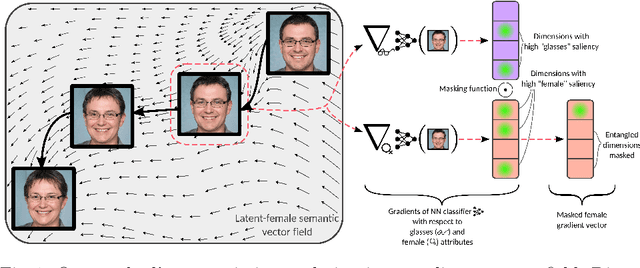


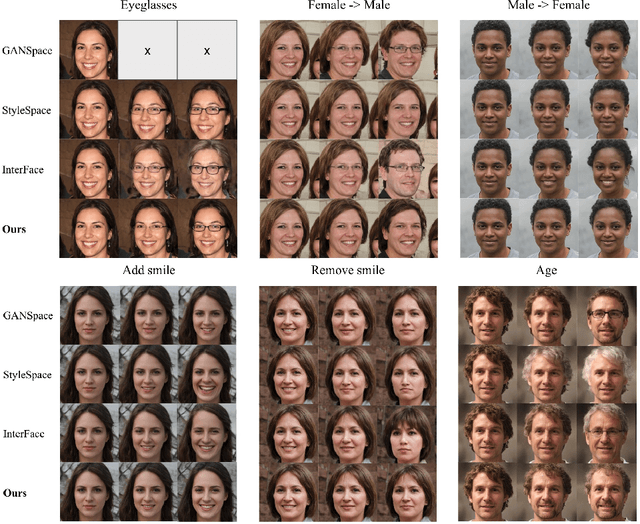
Abstract:Generative Adversarial Networks (GANs) have been widely applied in modeling diverse image distributions. However, despite its impressive applications, the structure of the latent space in GANs largely remains as a black-box, leaving its controllable generation an open problem, especially when spurious correlations between different semantic attributes exist in the image distributions. To address this problem, previous methods typically learn linear directions or individual channels that control semantic attributes in the image space. However, they often suffer from imperfect disentanglement, or are unable to obtain multi-directional controls. In this work, in light of the above challenges, we propose a novel approach that discovers nonlinear controls, which enables multi-directional manipulation as well as effective disentanglement, based on gradient information in the learned GAN latent space. More specifically, we first learn interpolation directions by following the gradients from classification networks trained separately on the attributes, and then navigate the latent space by exclusively controlling channels activated for the target attribute in the learned directions. Empirically, with small training data, our approach is able to gain fine-grained controls over a diverse set of bi-directional and multi-directional attributes, and we showcase its ability to achieve disentanglement significantly better than state-of-the-art methods both qualitatively and quantitatively.
Real-time Virtual-Try-On from a Single Example Image through Deep Inverse Graphics and Learned Differentiable Renderers
May 12, 2022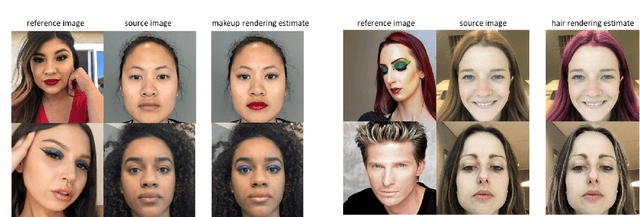
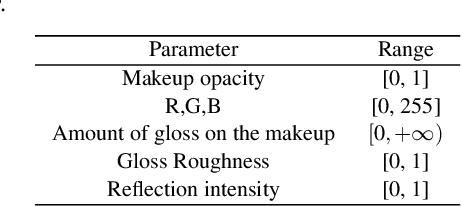
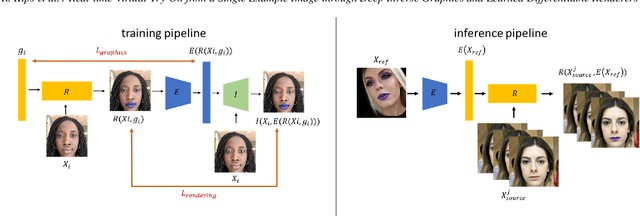
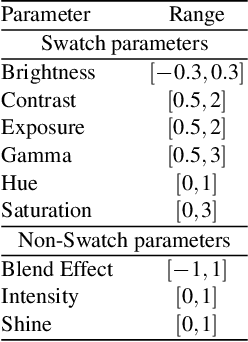
Abstract:Augmented reality applications have rapidly spread across online platforms, allowing consumers to virtually try-on a variety of products, such as makeup, hair dying, or shoes. However, parametrizing a renderer to synthesize realistic images of a given product remains a challenging task that requires expert knowledge. While recent work has introduced neural rendering methods for virtual try-on from example images, current approaches are based on large generative models that cannot be used in real-time on mobile devices. This calls for a hybrid method that combines the advantages of computer graphics and neural rendering approaches. In this paper we propose a novel framework based on deep learning to build a real-time inverse graphics encoder that learns to map a single example image into the parameter space of a given augmented reality rendering engine. Our method leverages self-supervised learning and does not require labeled training data which makes it extendable to many virtual try-on applications. Furthermore, most augmented reality renderers are not differentiable in practice due to algorithmic choices or implementation constraints to reach real-time on portable devices. To relax the need for a graphics-based differentiable renderer in inverse graphics problems, we introduce a trainable imitator module. Our imitator is a generative network that learns to accurately reproduce the behavior of a given non-differentiable renderer. We propose a novel rendering sensitivity loss to train the imitator, which ensures that the network learns an accurate and continuous representation for each rendering parameter. Our framework enables novel applications where consumers can virtually try-on a novel unknown product from an inspirational reference image on social media. It can also be used by graphics artists to automatically create realistic rendering from a reference product image.
Semantic Relation Preserving Knowledge Distillation for Image-to-Image Translation
May 19, 2021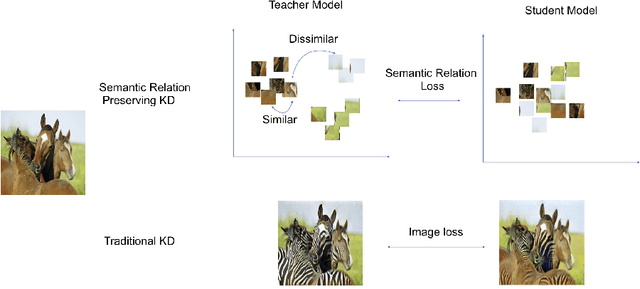
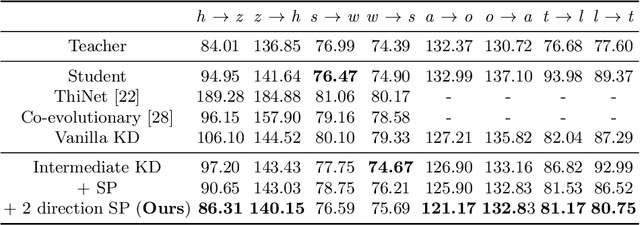
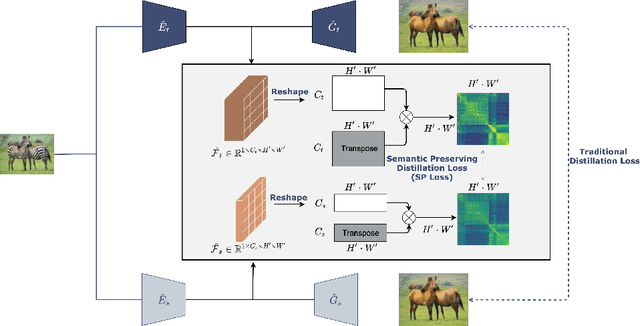

Abstract:Generative adversarial networks (GANs) have shown significant potential in modeling high dimensional distributions of image data, especially on image-to-image translation tasks. However, due to the complexity of these tasks, state-of-the-art models often contain a tremendous amount of parameters, which results in large model size and long inference time. In this work, we propose a novel method to address this problem by applying knowledge distillation together with distillation of a semantic relation preserving matrix. This matrix, derived from the teacher's feature encoding, helps the student model learn better semantic relations. In contrast to existing compression methods designed for classification tasks, our proposed method adapts well to the image-to-image translation task on GANs. Experiments conducted on 5 different datasets and 3 different pairs of teacher and student models provide strong evidence that our methods achieve impressive results both qualitatively and quantitatively.
Deep Graphics Encoder for Real-Time Video Makeup Synthesis from Example
May 12, 2021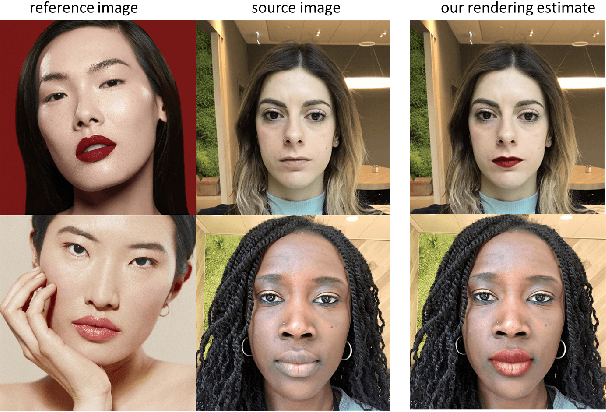
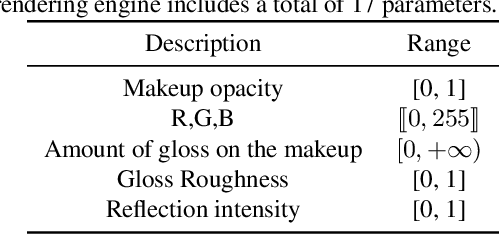


Abstract:While makeup virtual-try-on is now widespread, parametrizing a computer graphics rendering engine for synthesizing images of a given cosmetics product remains a challenging task. In this paper, we introduce an inverse computer graphics method for automatic makeup synthesis from a reference image, by learning a model that maps an example portrait image with makeup to the space of rendering parameters. This method can be used by artists to automatically create realistic virtual cosmetics image samples, or by consumers, to virtually try-on a makeup extracted from their favorite reference image.
Continuous Face Aging via Self-estimated Residual Age Embedding
Apr 30, 2021

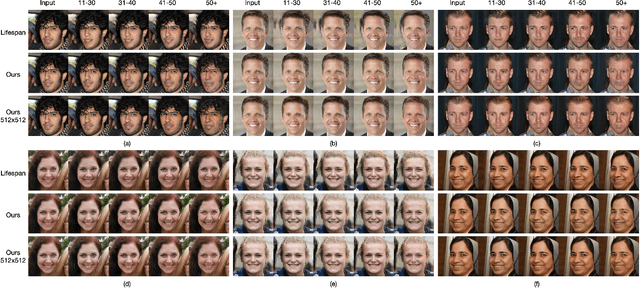

Abstract:Face synthesis, including face aging, in particular, has been one of the major topics that witnessed a substantial improvement in image fidelity by using generative adversarial networks (GANs). Most existing face aging approaches divide the dataset into several age groups and leverage group-based training strategies, which lacks the ability to provide fine-controlled continuous aging synthesis in nature. In this work, we propose a unified network structure that embeds a linear age estimator into a GAN-based model, where the embedded age estimator is trained jointly with the encoder and decoder to estimate the age of a face image and provide a personalized target age embedding for age progression/regression. The personalized target age embedding is synthesized by incorporating both personalized residual age embedding of the current age and exemplar-face aging basis of the target age, where all preceding aging bases are derived from the learned weights of the linear age estimator. This formulation brings the unified perspective of estimating the age and generating personalized aged face, where self-estimated age embeddings can be learned for every single age. The qualitative and quantitative evaluations on different datasets further demonstrate the significant improvement in the continuous face aging aspect over the state-of-the-art.
The GIST and RIST of Iterative Self-Training for Semi-Supervised Segmentation
Mar 31, 2021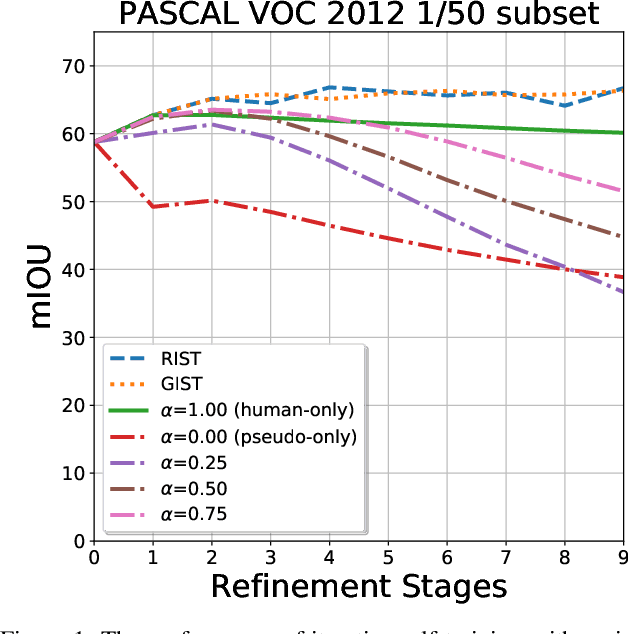
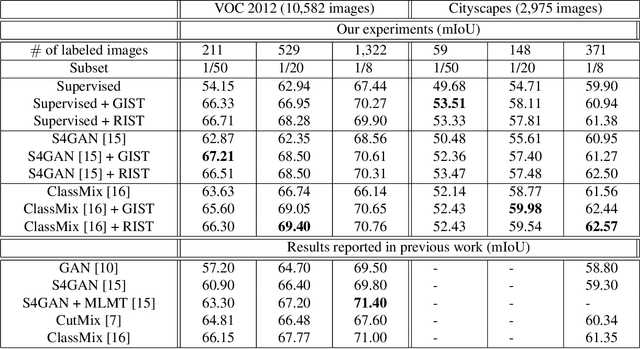
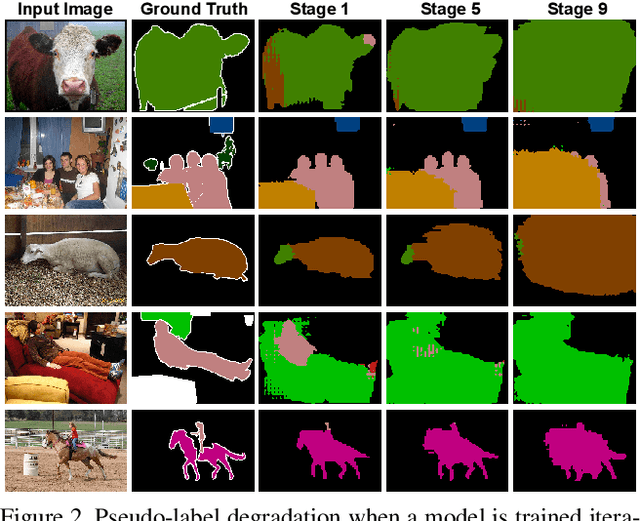
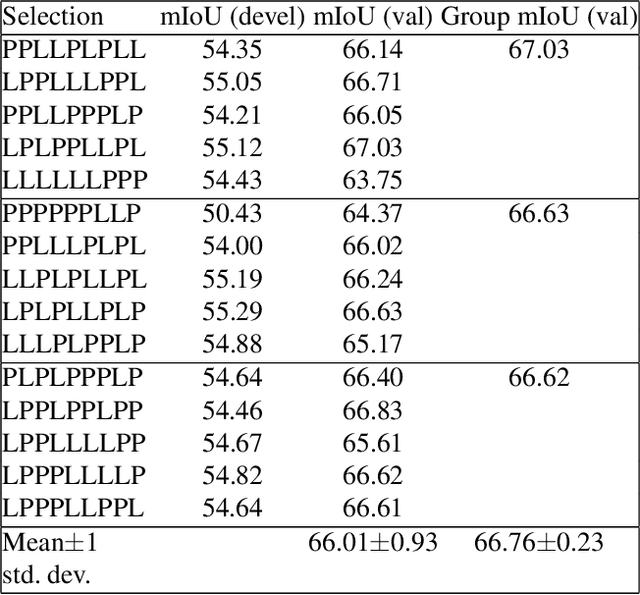
Abstract:We consider the task of semi-supervised semantic segmentation, where we aim to produce pixel-wise semantic object masks given only a small number of human-labeled training examples. We focus on iterative self-training methods in which we explore the behavior of self-training over multiple refinement stages. We show that iterative self-training leads to performance degradation if done naively with a fixed ratio of human-labeled to pseudo-labeled training examples. We propose Greedy Iterative Self-Training (GIST) and Random Iterative Self-Training (RIST) strategies that alternate between training on either human-labeled data or pseudo-labeled data at each refinement stage, resulting in a performance boost rather than degradation. We further show that GIST and RIST can be combined with existing SOTA methods to boost performance, yielding new SOTA results in Pascal VOC 2012 and Cityscapes dataset across five out of six subsets.
 Add to Chrome
Add to Chrome Add to Firefox
Add to Firefox Add to Edge
Add to Edge